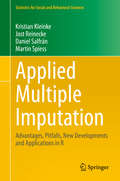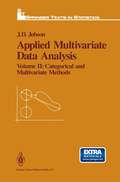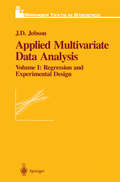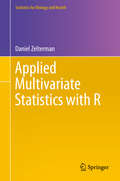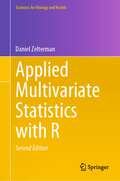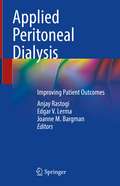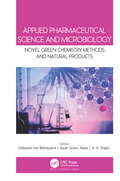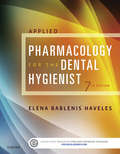- Table View
- List View
Applied Multiple Imputation: Advantages, Pitfalls, New Developments and Applications in R (Statistics for Social and Behavioral Sciences)
by Kristian Kleinke Jost Reinecke Daniel Salfrán Martin SpiessThis book explores missing data techniques and provides a detailed and easy-to-read introduction to multiple imputation, covering the theoretical aspects of the topic and offering hands-on help with the implementation. It discusses the pros and cons of various techniques and concepts, including multiple imputation quality diagnostics, an important topic for practitioners. It also presents current research and new, practically relevant developments in the field, and demonstrates the use of recent multiple imputation techniques designed for situations where distributional assumptions of the classical multiple imputation solutions are violated. In addition, the book features numerous practical tutorials for widely used R software packages to generate multiple imputations (norm, pan and mice). The provided R code and data sets allow readers to reproduce all the examples and enhance their understanding of the procedures. This book is intended for social and health scientists and other quantitative researchers who analyze incompletely observed data sets, as well as master’s and PhD students with a sound basic knowledge of statistics.
Applied Multivariate Data Analysis: Volume II: Categorical and Multivariate Methods (Springer Texts in Statistics)
by J.D. JobsonA Second Course in Statistics The past decade has seen a tremendous increase in the use of statistical data analysis and in the availability of both computers and statistical software. Business and government professionals, as well as academic researchers, are now regularly employing techniques that go far beyond the standard two-semester, introductory course in statistics. Even though for this group of users shorl courses in various specialized topics are often available, there is a need to improve the statistics training of future users of statistics while they are still at colleges and universities. In addition, there is a need for a survey reference text for the many practitioners who cannot obtain specialized courses. With the exception of the statistics major, most university students do not have sufficient time in their programs to enroll in a variety of specialized one-semester courses, such as data analysis, linear models, experimental de sign, multivariate methods, contingency tables, logistic regression, and so on. There is a need for a second survey course that covers a wide variety of these techniques in an integrated fashion. It is also important that this sec ond course combine an overview of theory with an opportunity to practice, including the use of statistical software and the interpretation of results obtained from real däta.
Applied Multivariate Data Analysis: Regression and Experimental Design (Springer Texts in Statistics)
by J.D. JobsonAn easy to read survey of data analysis, linear regression models and analysis of variance. The extensive development of the linear model includes the use of the linear model approach to analysis of variance provides a strong link to statistical software packages, and is complemented by a thorough overview of theory. It is assumed that the reader has the background equivalent to an introductory book in statistical inference. Can be read easily by those who have had brief exposure to calculus and linear algebra. Intended for first year graduate students in business, social and the biological sciences. Provides the student with the necessary statistics background for a course in research methodology. In addition, undergraduate statistics majors will find this text useful as a survey of linear models and their applications.
Applied Multivariate Statistics with R (Statistics for Biology and Health)
by Daniel ZeltermanThis book brings the power of multivariate statistics to graduate-level practitioners, making these analytical methods accessible without lengthy mathematical derivations. Using the open source, shareware program R, Professor Zelterman demonstrates the process and outcomes for a wide array of multivariate statistical applications. Chapters cover graphical displays, linear algebra, univariate, bivariate and multivariate normal distributions, factor methods, linear regression, discrimination and classification, clustering, time series models, and additional methods. Zelterman uses practical examples from diverse disciplines to welcome readers from a variety of academic specialties. Those with backgrounds in statistics will learn new methods while they review more familiar topics. Chapters include exercises, real data sets, and R implementations. The data are interesting, real-world topics, particularly from health and biology-related contexts. As an example of the approach, the text examines a sample from the Behavior Risk Factor Surveillance System, discussing both the shortcomings of the data as well as useful analyses. The text avoids theoretical derivations beyond those needed to fully appreciate the methods. Prior experience with R is not necessary.
Applied Multivariate Statistics with R (Statistics for Biology and Health)
by Daniel ZeltermanNow in its second edition, this book brings multivariate statistics to graduate-level practitioners, making these analytical methods accessible without lengthy mathematical derivations. Using the open source shareware program R, Dr. Zelterman demonstrates the process and outcomes for a wide array of multivariate statistical applications. Chapters cover graphical displays; linear algebra; univariate, bivariate and multivariate normal distributions; factor methods; linear regression; discrimination and classification; clustering; time series models; and additional methods. He uses practical examples from diverse disciplines, to welcome readers from a variety of academic specialties. Each chapter includes exercises, real data sets, and R implementations. The book avoids theoretical derivations beyond those needed to fully appreciate the methods. Prior experience with R is not necessary.New to this edition are chapters devoted to longitudinal studies and the clustering of large data. It is an excellent resource for students of multivariate statistics, as well as practitioners in the health and life sciences who are looking to integrate statistics into their work.
Applied Neurogenomics (Neuromethods #97)
by Kewal K. JainThis detailed volume reflects the considerable new developments that have taken place in the area of applied neurogenomics, particularly with the rapid progress in next generation sequencing. Beginning with an introduction to the technologies relevant to neurogenomics with an emphasis on next generation sequencing, the book also covers detailed methods relevant to the genomics of neurodegenerative diseases, particularly Alzheimer’s disease and Huntington’s disease, targeted sequencing of psychiatric disorders, as well as the role of genomics in the development of personalized neurology. Written in the popular Neuromethods series format, chapters provide the kind of practical description and implementation advice necessary to consistently produce successful results in the lab.Timely and convenient, Applied Neurogenomics serves as an invaluable reference for researchers working in this expanding, dynamic field.
Applied Neuroscience for the Allied Health Professions E-Book
by Frederike Van Wijck, BSc, MSc, PhD, Mcsp, Fhea D BSc Hons PhD, Frederike Van Wijc McBeanThis brand new resource provides a solid, comprehensive and accessible foundation in neurosciences for undergraduates and pre-registration postgraduate students. Using a multidisciplinary approach, it will guide students in their understanding of the most commonly found problems in neurological rehabilitation and inform their clinical practice. The book starts with the foundation of basic neurosciences, covering the normal function and structure of the nervous system from the organism as a whole through to the molecular level. It also introduces perceptuo-motor control and learning - topics that lie at the heart of rehabilitation. The book then goes on to discuss problems that allied health professionals commonly encounter in neurological rehabilitation. Topics covered include problems with perception and movement, planning, attention and memory, communication, motivation and emotion, sleep, continence and sexuality. The book also introduces key theories and evidence underpinning both behavioural and pharmacotherapeutic interventions used in neurological rehabilitation. The book closes by summarising current principles underpinning best practice and also looks to the future by identifying gaps in evidence-based practice with ideas for future research and what the future may hold for neurological rehabilitation. Throughout, a variety of supplementary information boxes point towards additional material such as Case Studies which highlight the clinical relevance of topics discussed; and a variety of Research Boxes which refer to more advanced material and/or original research studies. Each chapter ends with self-assessment questions which will check progress and prompt students to reflect on how the information presented in the chapter could be applied to clinical practice. Written by a multidisciplinary team, highly experienced in teaching, research and clinical practiceLays the foundation of basic neurosciences for allied health studentsAccessible and comprehensive text Introduces students to key theories and evidence underpinning neurological rehabilitationFocuses on clinically relevant informationEnd of chapter self-assessment questions of different levels of complexity
Applied Paramedic Law and Ethics: Australia and New Zealand
by Ruth Townsend Morgan LuckA fundamental local law text for undergraduate paramedics in Australia and New Zealand. Applied Paramedic Law and Ethics Australia and New Zealand is the first of its kind to bring together legal and ethical concepts specifically for the Australian and New Zealand paramedic profession. An indispensable guide for student paramedics, Applied Paramedic Law and Ethics Australia and New Zealand promotes the understanding of ethical principles and legal regulations through realistic scenarios and extensive case studies, which are available both in the book and on Elsevier’s Evolve platform. The book includes Australian state-specific legislation and local case law, and there is a chapter devoted specifically to the New Zealand paramedic service. This excellent law textbook focuses on the essential concepts and skills local paramedics need to respond to life-threatening emergencies in often-unfamiliar environments. For paramedics to determine the best course of action in any situation they need an intimate understanding of the profession’s code of conduct and current legal regulations. In its attention to key areas such as consent, negligence, child protection, mental health and record-keeping Applied Paramedic Law and Ethics Australia and New Zealand proves a fundamental resource for the undergraduate paramedic course in Australia and New Zealand. The textbook’s 13 comprehensive chapters are written in a clear, engaging style ideal for undergraduate paramedic students as well as ambulance service volunteers and practicing paramedics.Over 60 paramedic-specific scenarios Relevant case law discussedSuitable for the undergraduate course in Paramedic Law and EthicsProvides a clear ethical decision-making model for paramedics Key supporting features available on the Evolve platform:Multiple choice, short answer and essay questionsCase studies Image collectionAdditional instructor resources including PowerPoints and further case studies
Applied Paramedic Law, Ethics and Professionalism, Second Edition eBook: Australia and New Zealand
by Ruth Townsend Morgan LuckApplied Paramedic Law, Ethics and Professionalism brings together the legal and ethical principles relevant to paramedic profession in the Australian and New Zealand contexts. Written by Ruth Townsend and Morgan Luck, the text explores and explains the practical application of these principles through the use of case studies and paramedic-specific scenarios. An indispensable guide for student paramedics, and those already in the profession, the text helps to develop an awareness of the legal and ethical principles that guide professional practice. By engaging with the text, readers develop an understanding of the implications of their decisions and actions in a range of situations, as well as an understanding of their professional responsibilities.Additional case studies and short answer questions to support further learning Additional resources on Evolve eBook on VitalSource Student and instructor resources Multiple choice questionsCase studies Instructor resources PowerPointsShort answer questionsEssay questions Thoroughly revised content to reflect updated national standards for education and practice, the national Code of Conduct and guidelines set by the Paramedic Board of AustraliaNew chapters on privacy, employment law and researchAn eBook included in all print purchases
Applied Pathology for Ophthalmic Microsurgeons
by Gottfried O. H. Naumann L. Holbach F. E. KruseWritten and edited by the world-famous expert G.O.H. Naumann, this textbook delves into the details of ocular structures such as the nuances of morphology, surgical anatomy and pathology. The text covers unique features of intraocular surgery in closed system and open eye contexts. It goes on to cover crucial aspects of restoring the anterior chamber. Then it delineates the spectrum of potential complications in (pseudo-) exfoliation-syndromes as well as the most vulnerable cell populations. Readers are also treated to the features of normal and pathologic wound healing after non-mechanical laser and mechanical inventions. Brilliant artwork and sketches illustrate the complex pathology.
Applied Peritoneal Dialysis: Improving Patient Outcomes
by Edgar V. Lerma Anjay Rastogi Joanne M. BargmanThis book offers a comprehensive guide to peritoneal dialysis (PD). Home dialysis, and more specifically PD, is growing in popularity in the US. By conservative estimates, experts suggest that 45 percent of dialysis patients in the US can be on home dialysis. However, the current penetration rate is only 10 percent. This is changing with an expected major increase in the next 5 years. One of the reasons for the low uptake is that many nephrologists lack comfort and confidence in using PD as a dialysis modality. This book addresses those concerns by covering all aspects of PD. Chapters include its history, patient selection, implementation options, comorbidities, quality of life concerns, and developing approaches to treatment. This comprehensive resource fills the unmet need for a practical, hands-on book that is both detailed and can work as a quick reference. This is an ideal guide for academic nephrologists, private practice nephrologists, NPs, PAs, nurses, fellows, and residents.
Applied Pharmaceutical Practice and Nutraceuticals: Natural Product Development
by Debarshi Kar Mahapatra; Cristóbal Noé Aguilar; A. K. HaghiThe pharmaceutical industry recognizes the shift to the use of natural products while also considering the serious concerns that have arisen regarding the claimed efficacy, quality, and safety of these products. This volume showcases how pharmaceutical and nutraceutical compounds from natural products can be used to cure or prevent diseases. The chapters explore the connections between agrochemicals and pharmaceuticals and the use of plants and plant products in the formulation and development of new pharmaceuticals and nutraceuticals.
Applied Pharmaceutical Practice and Nutraceuticals: Natural Product Development
by Debarshi Kar Mahapatra Cristóbal Noé Aguilar A. K. HaghiThe pharmaceutical industry recognizes the shift to the use of natural products while also considering the serious concerns that have arisen regarding the claimed efficacy, quality, and safety of these products. This volume showcases how pharmaceutical and nutraceutical compounds from natural products can be used to cure or prevent diseases. The chapters explore the connections between agrochemicals and pharmaceuticals and the use of plants and plant products in the formulation and development of new pharmaceuticals and nutraceuticals.
Applied Pharmaceutical Science and Microbiology: Novel Green Chemistry Methods and Natural Products
by Debarshi Kar Mahapatra Swati Gokul Talele A. K. HaghiThis volume on applied pharmaceutical science and microbiology looks at the latest research on the applications of natural products for drug uses. It focuses on understanding how to apply the principles of novel green chemistry methods in the vital area of pharmaceuticals and covers the important aspects of green microbial technology in the pharmaceutical industry. Chapters include studies on the applications of natural products used in folk and regional medicines, such as for digestive problems, dermatological infections, respiratory diseases, vessel diseases, diarrhea and dysentery, ringworms, boils, fevers (antipyretic), skin and blood diseases, mouth sores, channel discharges, and even cancer. The volume also looks at medical benefit of microbial fermentation for the conservation of nutrients.
Applied Pharmacology E-Book
by Stan Bardal Jason Waechter Doug MartinApplied Pharmacology provides the essential details that are required for a solid understanding of pharmacology: how the drugs work, why side effects occur, and how the drugs are used clinically. Drs. Stan Bardal, Jason Waechter, and Doug Martin integrate the experience of the pharmacologist and the physician for a clinical focus that ensures a complete understanding of pharmacology...in print and online.Find information quickly and compare and contrast drugs easily thanks to a clear and consistent format without extraneous material. Apply basic pharmacology to clinical situations through integrated text. Enhance your learning with "For Your Information" sections detailing history and anecdotes for many agents within a given drug class. Find a wealth of additional resources online at www.studentconsult.com. Learn the essential details of pharmacology and enhance your understanding through an entirely new, fantastic art program.
Applied Pharmacology for the Dental Hygienist - E-Book
by Elena Bablenis HavelesCovering the most commonly used drugs in dentistry, Applied Pharmacology for the Dental Hygienist, 7th Edition provides an in-depth understanding of the pharmacologic principles needed for safe and effective dental treatment and oral health care. It discusses drug properties and mechanisms of action, dosages, intended effects, interactions, and adverse reactions — both for the medications a patient may already be taking and for the drugs prescribed by the dentist. New to this edition are topics such as drug-related osteonecrosis of the jaw, recommendations for antibiotic prophylaxis to reduce the risk of infection, cholesterol and cardiovascular guidelines, and new information on type 2 diabetes. Written by dental hygiene educator Elena Haveles, this trusted text prepares you for the expanding role of the dental hygienist!Comprehensive coverage provides an in-depth understanding of the most commonly used drugs, how they work, and how they affect patients’ oral health and dental treatment options. A dental focus addresses the drug interactions of clinical interest in dentistry, with explanations as to why certain drugs are used or contraindicated in a dental treatment plan.A logical format organizes chapters into four parts: 1) general pharmacologic principles, 2) drugs used in dentistry, 3) drugs that may alter dental treatment, and 4) special situations.Clinical Skills Assessment offers review questions at the end of each chapter, helping you assess your knowledge of the material.Dental Hygiene Considerations boxes show how principles of pharmacology apply specifically to dental hygienists.Note boxes highlight important concepts, indications, contraindications, memory tools, warnings, and more.Key terms are bolded and in color within each chapter and defined in a handy glossary. Summary tables and boxes serve as useful review and study tools with quick, easy-to-read summaries of key concepts.Learning objectives at the beginning of each chapter set goals for what you will accomplish and provide a useful study guide for examinations.A bibliography in each chapter lists resource citations for additional research and study of dental-related topics.Quick-reference appendixes include resources such as the top 200 drugs, medical acronyms, and information on herbal and dietary supplements.A drug index provides easy look-up of specific drugs and types of drugs. NEW! Updated coverage reflects the latest changes and advances relating to dental treatment, such as adverse drug reactions, antibiotic prophylaxis, osteonecrosis of the jaw, cardiovascular and cholesterol guidelines, oral anticoagulant drugs, and type 2 diabetes. NEW! Full-color design includes additional illustrations showing basic principles and internal processes, along with photographs of oral conditions and side effects.
Applied Pharmacology for the Dental Hygienist E-Book
by Elena Bablenis HavelesWith a focus on the most commonly used drugs in dentistry, Applied Pharmacology for the Dental Hygienist, 8th Edition provides you with an in-depth understanding of the pharmacologic principles needed for safe and effective dental treatment and oral health care. It discusses drug properties and mechanisms of action, dosages, intended effects, interactions, and adverse reactions - both for the medications a patient may already be taking and for the drugs prescribed by the dentist. This new edition has been updated throughout to give you a firm foundation in pharmacology in order to assess and educate patients so they can maintain optimal oral health!IMPROVED! Test Bank with cognitive leveling based on Bloom’s Taxonomy mapped to the National Board Dental Hygiene Examination (NBDHE) blueprint.Comprehensive coverage with a dental focus provides you with an in-depth understanding of the most commonly used drugs, how they work, and how they affect patients’ oral health and dental treatment options.Multiple opportunities for classroom and board exam prep offers summaries and review questions at the end of each chapter, helping you to assess your knowledge of the material.Key terms are bolded and in color within each chapter and defined in a handy glossary.Full-color design engages the reader and includes additional illustrations showing basic principles and internal processes, along with photographs of oral conditions and side effects.Separate drug index provides easy look-up of specific drugs and types of drugs.Quick-reference appendixes include resources such as the top 200 drugs, medical acronyms, and information on herbal and dietary supplements.NEW! Updated drug content throughout, including new side effects and warnings for many commonly seen drugs.NEW! Elsevier Animation Collection clips on Evolve includes systemic anatomy and physiology.
Applied Pharmacology for the Dental Hygienist,E-Book: Applied Pharmacology for the Dental Hygienist,E-Book
by Elena Bablenis Haveles**Selected for Doody's Core Titles® 2024 in Dental Hygiene & Auxiliaries** With a focus on the most commonly used drugs in dentistry, Applied Pharmacology for the Dental Hygienist, 9th Edition provides an in-depth understanding of the pharmacologic principles needed for safe and effective dental treatment and oral health care. It discusses drug properties and mechanisms of action, dosages, intended effects, interactions, and adverse reactions — both for the medications a patient may already be taking and for the drugs prescribed by the dentist. - Comprehensive coverage with a dental hygiene focus provides you with an in-depth understanding of the most commonly used drugs, how they work, and how they affect patients' oral health and dental treatment options. - Multiple opportunities for classroom and board exam prep offers a clinical case study and review questions at the end of each chapter and practice quizzes on the companion Evolve website to help you assess your knowledge of the material. - Learning features include Dental Hygiene Considerations, summary boxes and tables, and Note boxes to highlight key concepts. - Key terms are bolded and in color within each chapter and defined in a handy glossary for mastering vocabulary. - Engaging full-color design includes illustrations showing basic principles and internal processes, along with photographs of oral conditions and side effects. - Separate drug index provides easy look-up of specific drugs and types of drugs. - Quick-reference appendixes include resources such as medical terminology, medical acronyms, and information on dose calculations for children. - NEW! Updated drug content throughout, including new side effects and warnings for many commonly seen drugs.
Applied Pharmacology for Veterinary Technicians - E-Book: Applied Pharmacology for Veterinary Technicians - E-Book
by Lisa Martini-JohnsonLearn to calculate dosages accurately and administer drugs safely! Applied Pharmacology for Veterinary Technicians, 6th Edition shows you how to determine drug dosages, administer prescribed drugs to animals, and instruct clients about side effects and precautions. Coverage of drugs includes pharmacokinetics, pharmacodynamics, clinical uses, dosage forms, and adverse effects. An Evolve companion website offers animations of pharmacologic processes, practice with dosage calculations, narrated videos demonstrating drug administration techniques, and more. Written by veterinary technology educator Lisa Martini-Johnson, this resource provides the pharmacology knowledge you need to succeed as a vet tech!Quick-access format makes it easy to find important drug information, including clinical uses, dosage forms, and adverse side effects.Body systems organization follows a logical sequence of study.Illustrated, step-by-step procedures demonstrate proper administration techniques for common drug forms.Key terms, chapter outlines, Notes boxes, and learning objectives focus your learning and make studying easier.Proprietary drug names are listed with the generic drug names, highlighting drugs that have generic options.Companion Evolve website includes drug administration videos, drug calculators with accompanying word problems, animations of pharmacologic processes, and dosage calculation exercises.Dosage calculation exercises provide practice immediately after new information is presented.Review questions reinforce your understanding of key concepts, with answers located in the back of the book.Technician Notes provide useful hints and important reminders to help you avoid common errors and increase your efficiency on the job.NEW! Emergency Drugs chapter is added.UPDATED drug information keeps veterinary students current with the newest pharmacologic agents and their uses, adverse side effects, and dosage forms.NEW! Case studies at the end of every chapter provide students with real-world scenarios.
Applied Pharmacology for Veterinary Technicians - E-Book: Applied Pharmacology for Veterinary Technicians - E-Book
by Boyce P. Wanamaker Kathy MasseyNow in full color, Applied Pharmacology for Veterinary Technicians, 5th Edition shows you how to administer prescribed drugs to animals, calculate drug dosages accurately, and instruct clients about side effects and precautions. Coverage of drug information includes pharmacokinetics, pharmacodynamics, clinical uses, dosage forms, and adverse effects. An Evolve companion website enhances the book with narrated videos demonstrating drug administration techniques, animations of pharmacologic processes, dosage calculation exercises, and much more. Written by veterinary technology experts Boyce Wanamaker and Kathy Lockett Massey, this resource provides the pharmacology knowledge you need to succeed as a vet tech! - Illustrated, step-by-step procedures demonstrate proper administration techniques for common drug forms. - Body systems organization provides a logical sequence of study, followed by anti-infectives, antiparasitics, anti-inflammatory agents, and others. - Dosage calculation exercises provide practice immediately after new information is presented. - Proprietary drug names are listed with generic drug names, highlighting drugs with generic options. - Review questions reinforce understanding of key concepts, with answers located in the back of the book. - An Evolve companion website provides drug administration videos, drug calculators with accompanying word problems, photos of drug labels, animations of pharmacologic processes, and dosage calculation exercises. - Key terms, chapter outlines, and learning objectives at the beginning of each chapter make studying easier. - Technician Notes provide useful hints and important reminders to help you avoid common errors and increase your efficiency. - UNIQUE Pharmacy Management and Inventory Control chapter offers practical tips relating to vendor types, communicating with sales representatives, and using veterinary practice management software. - Now in full color, UPDATED drug information keeps you current with the latest pharmacologic agents and their uses, adverse side effects, and dosage forms. - NEW coverage of stem cell treatment in Immunologic Drugs chapter addresses scientific advances in this area. - UPDATED fluid therapy chapter explains the role of parenteral fluids, oral fluids, and nutritional products in drug therapy.
Applied Pharmacometrics (AAPS Advances in the Pharmaceutical Sciences Series #14)
by Stephan Schmidt Hartmut DerendorfThis comprehensive volume provides an update on the current state of pharmacometrics in drug development. It consists of nineteen chapters all written by leading scientists from the pharmaceutical industry, regulatory agencies and academia. After an introduction of the basic pharmacokinetic and pharmacodynamic concepts of pharmacometrics in drug development, the book presents numerous examples of specific applications that utilize pharmacometrics with modeling and simulations over a variety of therapeutic areas, including pediatrics, diabetes, obesity, infections, psychiatrics, Alzheimer’s disease, and dermatology, among others. The examples illustrate how results from all phases of drug development can be integrated in a more timely and cost-effective process.Applying pharmacometric decision tools during drug development can allow objective, data-based decision making. At the same time, the process can identify redundant or unnecessary experiments as well as some costly clinical trials that can be avoided. In addition to cost saving by expedited development of successful drug candidates, pharmacometrics has an important economic impact in drug product selection. Unsuccessful drug candidates can be identified early and discontinued without expending efforts required for additional studies and allocating limited resources. Hence, pharmacometric modeling and simulation has become a powerful tool to bring new and better medications to the patient at a faster pace and with greater probability of success.
Applied Photochemistry
by Rachel C. Evans, Peter Douglas and Hugh D. BurrowsApplied Photochemistry encompasses the major applications of the chemical effects resulting from light absorption by atoms and molecules in chemistry, physics, medicine and engineering, and contains contributions from specialists in these key areas. Particular emphasis is placed both on how photochemistry contributes to these disciplines and on what the current developments are.The book starts with a general description of the interaction between light and matter, which provides the general background to photochemistry for non-specialists. The following chapters develop the general synthetic and mechanistic aspects of photochemistry as applied to both organic and inorganic materials, together with types of materials which are useful as light absorbers, emitters, sensitisers, etc. for a wide variety of applications. A detailed discussion is presented on the photochemical processes occurring in the Earth’s atmosphere, including discussion of important current aspects such as ozone depletion. Two important distinct, but interconnected, applications of photochemistry are in photocatalytic treatment of wastes and in solar energy conversion. Semiconductor photochemistry plays an important role in these and is discussed with reference to both of these areas. Free radicals and reactive oxygen species are of major importance in many chemical, biological and medical applications of photochemistry, and are discussed in depth. The following chapters discuss the relevance of using light in medicine, both with various types of phototherapy and in medical diagnostics. The development of optical sensors and probes is closely related to diagnostics, but is also relevant to many other applications, and is discussed separately. Important aspects of applied photochemistry in electronics and imaging, through processes such as photolithography, are discussed and it is shown how this is allowing the increasing miniaturisation of semiconductor devices for a wide variety of electronics applications and the development of nanometer scale devices. The final two chapters provide the basic ideas necessary to set up a photochemical laboratory and to characterise excited states. This book is aimed at those in science, engineering and medicine who are interested in applying photochemistry in a broad spectrum of areas. Each chapter has the basic theories and methods for its particular applications and directs the reader to the current, important literature in the field, making Applied Photochemistry suitable for both the novice and the experienced photochemist.
Applied Photochemistry: When Light Meets Molecules (Lecture Notes in Chemistry #92)
by Serena Silvi Giacomo BergaminiThis monograph features what happens when light meets molecules. This edited volume contains contributions from an international array of contributors, and it is divided into sections representing a selection of carefully focussed and connected photochemistry topics: energy, technology, medicine, environmental sciences, and art. In each section one or more chapters illustrates relevant aspects of each field, such as artificial photosynthesis and solar energy conversion (energy), light emitting devices and photochromic dyes (technology), and photodynamic therapy and solar filters (medicine). Aimed at students of all levels and researchers active in photochemistry.
Applied Physics of External Radiation Exposure: Dosimetry and Radiation Protection (Biological and Medical Physics, Biomedical Engineering)
by Rodolphe Antoni Laurent BourgoisThis book describes the interaction of living matter with photons, neutrons, charged particles, electrons and ions. The authors are specialists in the field of radiation protection. The book synthesizes many years of experiments with external radiation exposure in the fields of dosimetry and radiation shielding in medical, industrial and research fields. It presents the basic physical concepts including dosimetry and offers a number of tools to be used by students, engineers and technicians to assess the radiological risk and the means to avoid them by calculating the appropriate shields. The theory of radiation interaction in matter is presented together with empirical formulas and abacus. Numerous numerical applications are treated to illustrate the different topics. The state of the art in radiation protection and dosimetry is presented in detail, especially in the field of simulation codes for external exposure to radiation, medical projects and advanced research. Moreover, important data spread in different up to date references are presented in this book. The book deals also with accelerators, X-rays facilities, sealed sources, dosimetry, Monte Carlo simulation and radiation regulation. Each chapter is split in two parts depending on the level of details the readers want to focus on. The first part, accessible to a large public, provides a lot of simple examples to help understanding the physics concepts under radiation external exposure. The second part, called “Additional Information” is not mandatory; it aims on explaining topics more deeply, often using mathematical formulations. The book treats fundamental radiometric and dosimetric quantities to describe the interaction in materials under the aspects of absorbed dose processes in tissues. Definitions and applications on limited and operational radiation protection quantities are given. An important aspect are practical engineering tools in industrial, medical and research domains. Source characterization and shielding design are addressed. Also more ”exotic” topics, such as ultra intense laser and new generation accelerators, are treated. The state of the art is presented to help the reader to work with the book in a self-consistent way. The basic knowledge necessary to apply Monte Carlo methods in the field of radiation protection and dosimetry for external radiation exposure is provided. Coverage of topics such as variance reduction, pseudo-random number generation and statistic estimators make the book useful even to experienced Monte Carlo practitioners. Solved problems help the reader to understand the Monte Carlo process. The book is meant to be used by researchers, engineers and medical physicist. It is also valuable to technicians and students.
